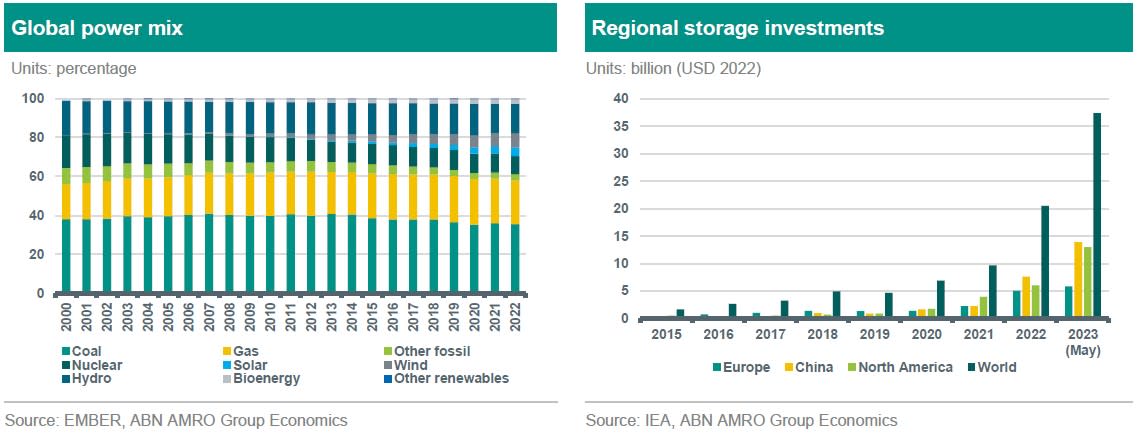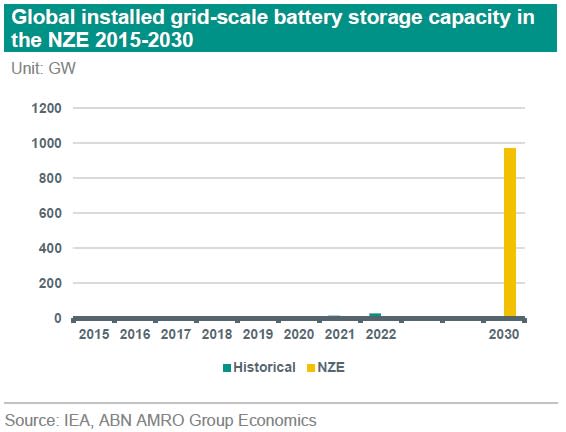SustainaWeekly - Solutions for grid scale storage

Grid scale storage refers to the use of power storage technologies connected to the grid to store excessive power when demand is low or supply is high and feed it back to the grid when needed. In this edition of the SustainaWeekly, we first look at the various options for grid scale storage. We then go on to look at the economics of renovating buildings in terms of the savings from energy costs, this time for the UK residential building sector. Finally, we use various indicators to see whether the Climate sector Industry is moving at a sufficient pace to reduce emissions.
Economist: Grid scale storage is essential to meet Net Zero targets by ensuring grid stability as the share of renewables in the power mix increases. Pumped-storage hydropower, electrochemical batteries, and green hydrogen are among the widely scalable technologies that can be used. While thermal and mechanical storage are promising, especially for long duration storage, they need time to reach scalable maturity.
Strategist: The UK residential building space has significant energy renovation requirements. The valuation uplift from improving the energy efficiency, measured by means of the EPC, seems less pronounced for UK properties. Still, the high savings on energy cost from renovation still make such renovations attractive, despite the lack of subsidies and a high financing rate.
Sector: By 2022, the climate sector Industry was the largest consumer of energy with a 32% share of total final energy consumption. Still the energy mix of the climate sector Industry is dominated by fossil fuels, especially natural gas and oil. So far, the pace in the transition to more renewable energy is still slow; this is actually also true for the overall greening of the sector but sustainable steps have been taken.
ESG in figures: In a regular section of our weekly, we present a chart book on some of the key indicators for ESG financing and the energy transition.
Saving power for the darkest cold nights
Grid scale storage is essential to meet Net Zero targets by ensuring grid stability as the share of renewables in the power mix increases
Pumped-storage hydropower, electrochemical batteries, and green hydrogen are among the widely scalable technologies that can be used for grid-scale storage driven by their cost efficiency and government support
Other technologies like thermal and mechanical storage are promising, especially for long duration storage, but they need time to reach scalable maturity
The longer it takes to build the needed storage capacity, the longer natural gas will be needed to smooth out power supply and provide stability to the grid, and the longer the period that Europe will be vulnerable to the supply of natural gas
Introduction
Grid scale storage refers to the use of power storage technologies connected to the grid to store excessive power when demand is low or supply is high and feed it back to the grid when needed. It plays a role in stabilizing the grid.
With more investments going into renewable power sources, such as wind and solar, power systems become more and more vulnerable because of the intermittency of renewables. The higher the share of renewables in the power mix, the higher the need for more storage capacity. Therefore, storage is envisioned to play an essential role in the energy transition by providing security and flexibility to the grid and power markets. This role is being acknowledged by different countries, as seen in the figure below, which depicts a rising share of renewables in the global power mix (left hand panel), associated with a rise of investments in storage capacity (right hand panel).

The first thing that comes to mind when thinking about storing power is the use of electrochemical batteries. Other (innovative) solutions to store power have also been emerging with some promising technologies. This note touches up on recent developments in the power storage technologies, the associated pros and cons, and their potential role in the transition.
Electrochemical batteries
The past few years have witnessed the emergence of new generations of electrochemical batteries that have seen improvements in their cost and efficiency, such as lithium-ion batteries, which are widely used in the electrification of final sectors, such as transportation. With regard to the storage at the grid level, the feasibility of large scale batteries is growing and are already taking place. For example, the Moss Landing Energy Storage Facility in California, with 300 MW, and the Hornsdale power reserve in South Australia, with a capacity of 150 MW.
Moreover, other storage solutions that take advantage of the fleet of batteries embedded in Electric Vehicles (EV) is being proposed and promoted, by using the so-called bi-directional charging. The concept depends on the ability to access the power stored in EV batteries by feeding it back to the grid when needed. Bi-directional charging relies on optimizing and managing the time of (dis)charging EV batteries connected to the grid. Accordingly, these batteries are charged when there is excessive supply of renewable energy and discharged when demand is peaking or when renewable energy is halted or redundant. More details on bidirectional charging can be found in our earlier 8th of May Sustainaweekly.
One of the main disadvantages of electrochemical batteries is their vulnerability to degradation as time passes as they rely on chemical processes that lose efficacy over time. Furthermore, the fact that these batteries need to be used on a regular basis to maintain their efficacy make them inappropriate for long term storage. Moreover, these batteries have as adverse environmental impact associated with the emissions from the production/mining of materials such as lithium and other minerals. These metals are also scarce and/or critical. Accordingly, the cost of these batteries is sensitive to the prices of these minerals which makes their cost vulnerable to any development in the mineral markets.
Pumped storage hydropower
Also called water-batteries. From its name this technology relies on excessive renewable power to pump water up to fill in water reservoirs behind dams or waterfalls. The water is consequently released to move electrical turbines that generate power when needed. According to IEA, this type of storage will constitute a large share of new investments in hydropower in Europe and China.
This technology is appropriate for long duration storage and its operational cost is quite cheap once the initial infrastructure is built. But there are many specificities and challenges to this technology that limit its adoption. For example, hydro-storage cannot be applied everywhere, rather, it is only viable in regions abundant with water resources with elevated landscape or mountains. Additionally, hydro projects are capital intensive for the initial infrastructure, which could be prohibitive for some countries.
Thermal energy storage
There are several technologies under this kind of storage that mainly differ in the material used to store energy, but the concept is the same: excessive heat or renewable power is converted to heat which consequently conserved using different materials, and the heat is converted back to electricity that feeds back to the grid when needed. Thermal storage is carried out under controlled conditions and specifications that minimize the leakage of heat, with no or very low daily loss rate. Thus, these technologies can deliver long duration conservation of heat. For example, excessive renewable power could be used to heat up an array of brick to high industrial temperatures as achieved by a pilot project by a startup in the US using bricks as the main material to store heat for days with a daily 1% loss rate (). Another example would be to use sand to preserve heat in a well isolated container with heat pipes and using this heat later to generate power. In Finland a start-up was able to build a relatively cheap sand battery with 8 MWh maximum capacity of thermal energy, which gives back around 200kW of power. The very tight isolation used in the battery allows it to conserve heat for months in very low temperatures ().
The thermal storage technologies mentioned above are promising in that they could be eventually scaled up to a grid-level storage. The cheap and abundant nature of their material inputs is their advantage compared to materials needed for electrochemical batteries. For example, sand batteries are up to 10 times cheaper than their lithium-ion counterparts. However, a dis-advantage of sand batteries is that they save up to 10 times lower energy for the same unit volume than lithium batteries. Another disadvantage for thermal batteries lies in conversion loss from heat back to power which is still high at this stage. One solution could be channelling the excessive heat back to use it in central or industry heating.
Green hydrogen
Green hydrogen is made using renewable energy by separating the water molecules through the electrolysis process using electrolysers. The main condition for hydrogen to be labelled as ‘green’ is to use renewable electricity to produce it. Within Europe, and even globally, green hydrogen is envisioned as playing a prominent role in power storage as an energy carrier. Europe has set up an ambitious strategy to boost investments in the green hydrogen value chain, such as strengthening renewable power capacity, holding a leading role in the manufacturing of electrolysers, and aiming to boost green hydrogen demand from hard to abate sectors.
Green hydrogen has many advantages. In comparison with other storage alternatives, green hydrogen is convenient for long duration storage (for example seasonal storage). It also can be used as a feedstock fuel for many sectors and can be transported from one place to another off the power grid by using repurposed gas pipelines, which relieves the pressure on the grid to transport electricity to where it is needed without the need to extend the grid. Though, still the high conversion loss associated to green hydrogen is one major disadvantage. Additionally, technology 1) and market immaturities hold back private investments at scale.
Mechanical batteries
One kind of mechanical storage relies on the physics of gravity. The idea is simple: using cheap renewable electricity, when supply is excessive, to lift weights up, and harness back this power in times of high demand and price rise by releasing these weights to fall and power a generator with the downward gravitational pull.
The upside of this technology is the storage duration. Due to its nature, this kind of storage can be considered a long term storage. Another upside of gravity storage is that the discharge of power is almost instant which saves time compared with other alternatives and hence makes it appropriate to maintain the balance of the grid (). A downside for this technology is possible breaks of its mechanical parts. However, the possible repairability of the physical parts of gravity based storage extends it lifetime to up to 50 years, which outperform other technologies such as electrochemical ones.
Some other mechanical storage technologies involve the use of renewable power to compress air/gas, and consequently, by using heat, expanding the compressed air/gas in a turbine, which can then generate electricity whenever needed. This storage technology has been used since the 18th century.
Grid-scale storage and the transition process
According to the IEA, grid scale battery storage has a role to meet the Net-Zero targets, as illustrated in the figure below. So far pump-storage hydropower is the most used grid storage wherever appropriate. Electrochemical batteries are catching up and spreading fast because of the recent reductions in their cost. Mechanical batteries have a limited role in current power system, while thermal storage, is on its early stages of development and needs time to reach a scalable maturity. Finally, green hydrogen is envisioned to scale up fast in the upcoming years benefiting from government support.

Before the energy crisis, and because of its relatively lower emissions compared to other fossil fuels, natural gas was envisage as being a transition fuel in Europe to smooth out any fluctuations in power supply caused by the natural intermittency of renewables. After the Russian invasion of Ukraine, Europe has set a goal to reduce its reliance on Russian gas. Thus, building up sufficient storage capacity to reduce the role of natural gas in balancing the grid became a strategic priority. Thus, the longer it takes to build the needed storage capacity, the longer natural gas will be needed to smooth out power supply and provide stability to the grid, and the longer the period that Europe will be vulnerable to the supply of natural gas.
1) Green hydrogen that relies on Alkaline or PEM electrolysers is on a demonstration-early adoption phase, while green hydrogen produced using solid oxides electrolyser is at large prototype/demonstration phase.

